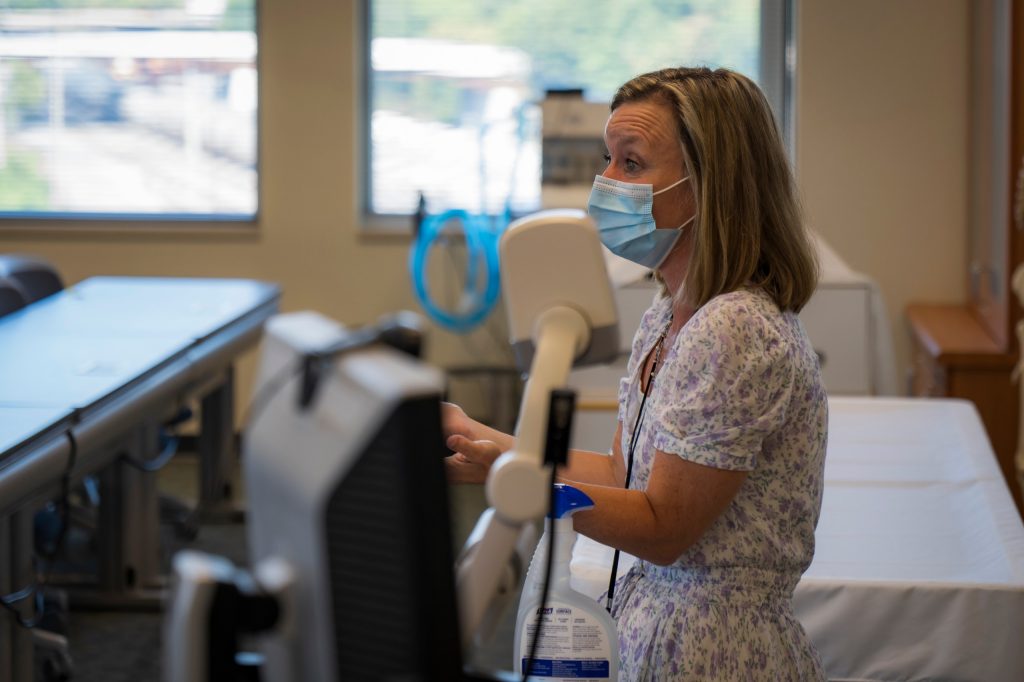
Each year, flu season brings coughs, sore throats, fevers, chills, and other respiratory troubles to about 8 percent of the U.S. population, on average. Throw in a pandemic caused by the outbreak of COVID-19 this year, and it is a true collision of viruses.
That’s why protection against the flu may be more important than ever, said Cynthia Morrow, who is co-leader of the Health Systems Science and Interprofessional Practice domain at the Virginia Tech Carilion School of Medicine.
But how are the flu and the coronavirus different and can you have both at the same time?
Morrow, who also directs the Roanoke City and Alleghany Health Districts, answered questions about the viruses and offered advice for staying safe.
- How are the flu and the coronavirus similar?
Morrow: They are both contagious respiratory infections, and they are both primarily spread through respiratory droplets. The most common ways they are spread is through close personal contact, when a person breathes in those droplets.
Unlike most other diseases, with respect to influenza and the coronavirus, you can start shedding the virus before you even know that you are sick. In other words, you can be contagious to other people before you have any symptoms. Also, some of the symptoms, such as fever, cough, and body aches, can be quite similar.
- How are the two viruses different?
Morrow: One key difference is that we have a vaccine for the flu, and we don’t have one for SARS-CoV-2 (the virus that causes coronavirus) at this time. Another important difference is that they both can present with mild to severe illness, but COVID-19 is more likely to cause more serious illness in more people.
Also, its incubation period seems to be a little bit longer. The time between exposure and onset of illness is longer. With the flu, we think that people might be shedding the virus 24 hours before they are sick. With COVID-19, it could be up to 48 hours before they are sick.
In addition to being able to be infected without symptoms, people are contagious with COVID-19 longer (about 10 days) than with the influenza (about five to seven days).
- Can physical distancing and wearing face coverings in public decrease the spread of the flu?
Morrow: Absolutely. Because the viruses are transmitted in a similar way, through droplets, and because they are contagious with droplets, anything to reduce the spread of droplets is going to be protective for both viruses.
We protect other people by staying home when we are sick, by wearing masks, and also by washing our hands. It’s the same idea.
What’s really interesting is that there was decreased influenza activity in the Southern Hemisphere in 2020. One of the factors could be because of the interventions against SARS-CoV-2.
- Can getting a flu shot make a person less likely to contract the coronavirus?
Morrow: No, it’s really important for us to keep the two viruses separate. The influenza vaccine is for influenza viruses. It lowers your risk of getting influenza. It is the best tool that we have.
One thing that we hope is if people get vaccinated [for the flu], and if they do get sick, it makes us more likely to distinguish the two viruses. A lot of providers are testing for both [flu and COVID-19].
- Is it possible to have both the flu and COVID-19 at the same time?
Morrow: It is possible to get both of them at the same time, which is even more reason to get the flu vaccine. It’s not common, but we know from the spring that it has happened, and there has already been one person this fall who has tested positive for both viruses.
- What is the best way for someone to protect themselves from contracting the flu?
Morrow: The three C’s are helpful to prevent virus outbreaks — avoid closed spaces, avoid close contact, and avoid crowded places.
- Why is getting a flu shot important this year?
Morrow: It is always important, but there are many reasons why it’s even more important now. Not only is it important for the individual, it’s important for the health system. We already have a health system that is being challenged [by COVID-19].
We don’t know what COVID-19 is going to do in the next few months, but while we are waiting for a vaccine, we have to be prepared for COVID-19 to continue to threaten our communities. The more people who get flu shots, the fewer will end up in the health system, and for those people who really need the ICU beds and the ventilators, they can access them.




